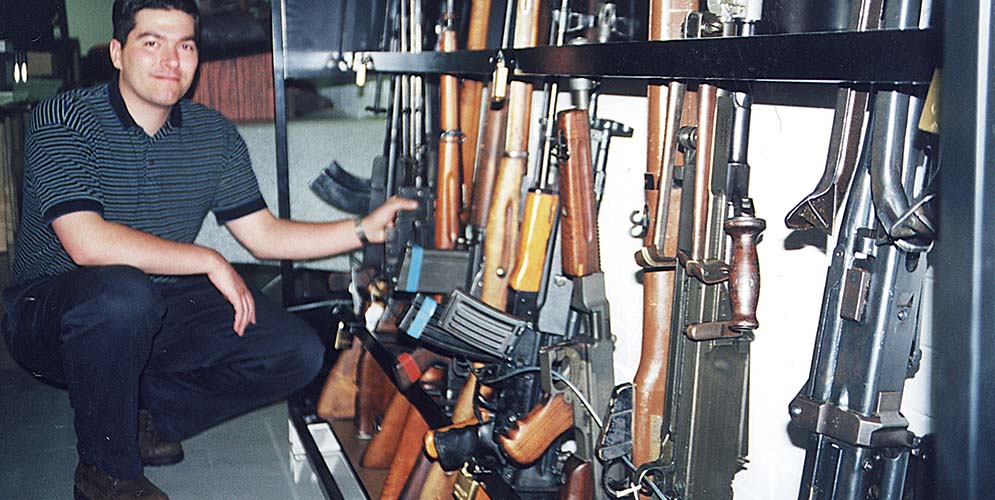By Rob Krott
Since I happened to be in town visiting a friend I decided to visit the Loyal Edmonton Regiment’s museum in Edmonton, Alberta Canada. I phoned the museum curator, Chad Slee, and expressed my interest in viewing the Loyal Edmonton Regiment’s weapons collection. I made an appointment to stop by, view their weapons displays, and meet with Chad and the Weapons Collection Manager, Terry Allison, for a tour.
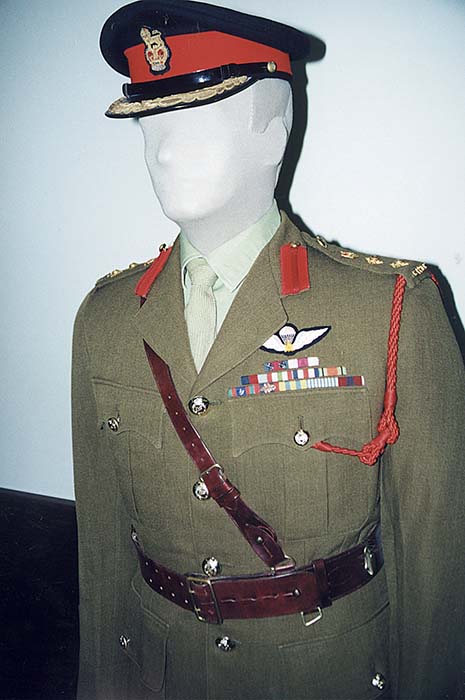
The museum is housed in a former drill hall or armory which is now the Prince of Wales Armouries Heritage Center. It is a large and attractive building under auspices of the City of Edmonton Archives and the Alberta Genealogical Society.
“Fears No Foe”
The Griesbach gallery containing two dozen or so cases of uniforms, weapons, millitaria, and equipment (mostly from World War I and World War II) is the focal gallery of the museum. This is based on the story line of the regiment from its inception and establishment to its present day role in the Canadian Armed Forces. The Gallery is named after Major-General the Honourable William Antrobus Griesbach CB, CMG, DSO, VD, DC, the first Commanding Officer of the 49th Battalion and considered to e the “founder” of the regiment. He was also an Edmonton Alderman and Mayor and Federal Member of Parliament and Senator. The regiment traces its roots back to the first infantry unit raised in Alberta (1 April 1908) and over the years has carried various names including the 101st Regiment, Edmonton Fusiliers, 49th Battalion, Canadian Expeditionary Force, The Edmonton Regiment, the Loyal Edmonton Regiment. The regiment’s motto is “Fears No Foe” and the Colonel-In-Chief is the Right Houourable Countess Mountbatten of Burma, CD, JP, DL, CBE.
The Griesbach Gallery
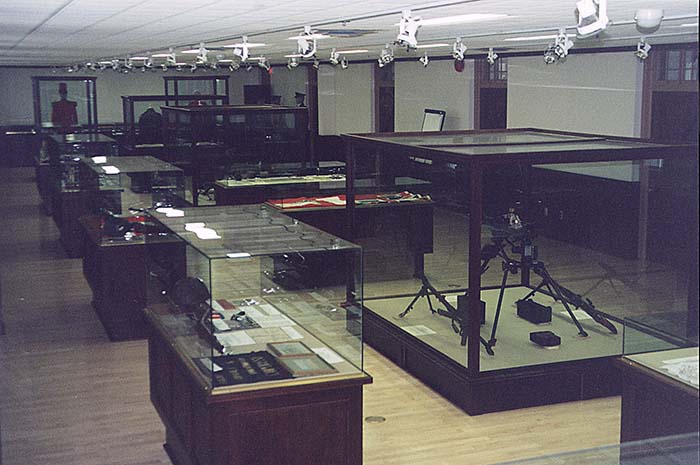
Entering the gallery there are a display cases containing various uniforms representing the regiment’s long history. There are also medals displays of the men who earned such lofty awards as the DSO ( Distinguished Service Order), the Military Cross, and the Military Medal. The small arms in this gallery are well representative of World War I and World War II (Several men in the regiment saw active service in both world wars). Notably there is a Lewis MK 1 “ground” machine gun, a Vickers .303, and a Bren gun in one case and in another are an MG-42, an MG34, and an MG13 (7.92X57mm Mauser) which usually fired from a 75 round saddle drum (doppeltrommel) or a 25 round box magazine. This one was equipped with a box magazine. The MG13s were manufactured from rebuilt Dreyse machineguns left over from WWI by fitting a perforated barrel jacket, a tubular butt, and a bipod. Replaced by the MG34, the Mg13s were sold to Portugal where they remained in service until about 1950. The MG34 mounts Zielfernrohr 40 – the later type of optical sight used for the MG42. This one is missing a small component on top. A simpler optical sight, the Zielfernrohr 34, was originally used with the MG34.
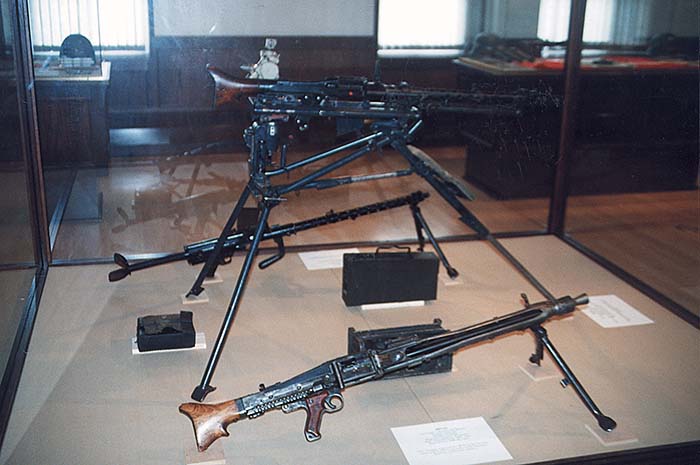
The Loyal Edmonton Regiment Museum also has a very nice display centering around my favorite assault rifle: two MP43/44 Sturmgewehr flank a German NSDAP battle flag. In the same case is a near mint condition SA Dagger (“Alles Fur Deutschland”). The Nazi blade was captured in Holland by a member of the regiment. And of course no collection of WWII firearms would e complete without a Mauser 98K.
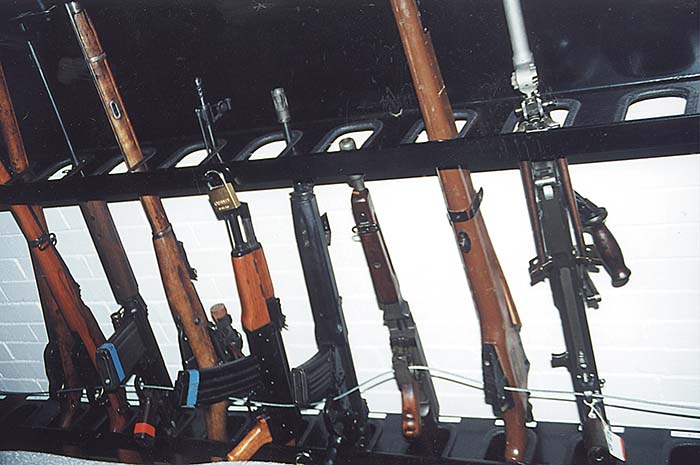
An interesting display is the captured Italian Army Issue Mannlicher-Carcano Carine, chambered for 6.5 X 57mm Mannlicher. A placard in the display case notes: “President Kennedy was shot with this type of weapon”
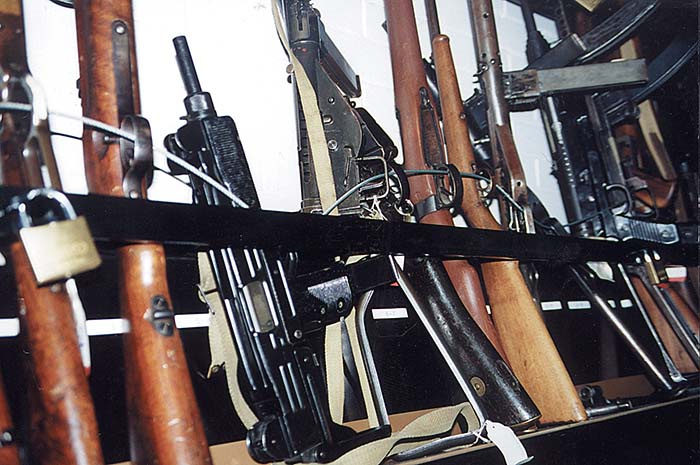
The Stone Gallery
Another hall in the museum is the Stone Gallery, named after Colonel James Riley Stone, DSO and Bar, MC. Riley left Edmonton as a private n 1939, was commissioned in March 1942, and rose through the ranks to Lieutenant Colonel and command of the Regiment in Italy in 1944. He commanded the 2nd Battalion, Princess Patricia’s Light Infantry during the Korean War.
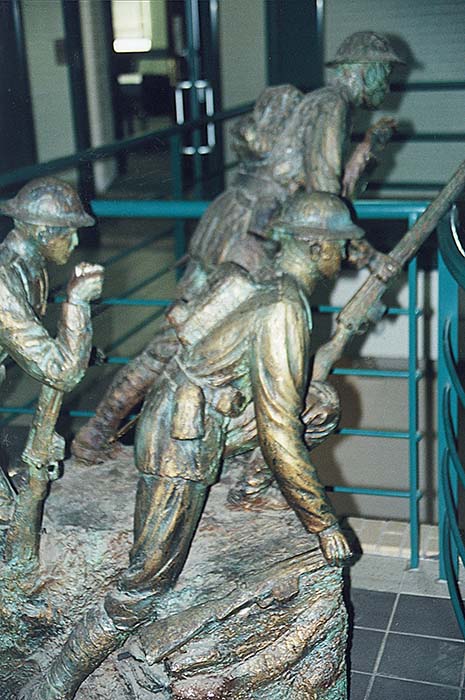
The Stone Gallery (Due to open this year) focuses on the recognition of all the other military services and units organized in central and northern Alberta. Its fluid story line will continuously rotate displays with themes including RCAF, RCN, such individual services as the RCAF, RCN; specific units; and paramilitary organizations (e.g. the Royal Canadian Army Cadets). In recent years the regiment has sent many of its members off to peacekeeping duties around the world and the museum’s “UN Peacekeeping Display” is pending. It will highlight the regiment’s participation in the Korean War and more recent conflicts and hotspots with several modern weapons related to those events on display. Chad escorted me through the still uncompleted gallery and I noted placards in place for several WWII/Korean War era US made weapons.
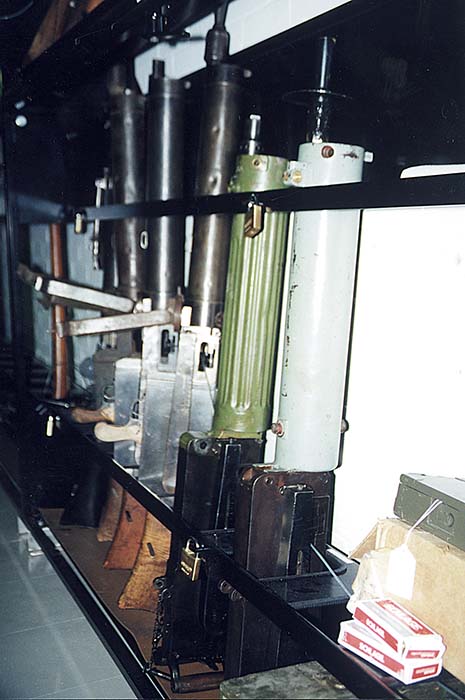
In The Basement
After viewing the weapons in the regiment’s collection not on display. Space restrictions don’t allow for display of many of the weapons, but some are slated for exhibits in the new Stone Gallery.
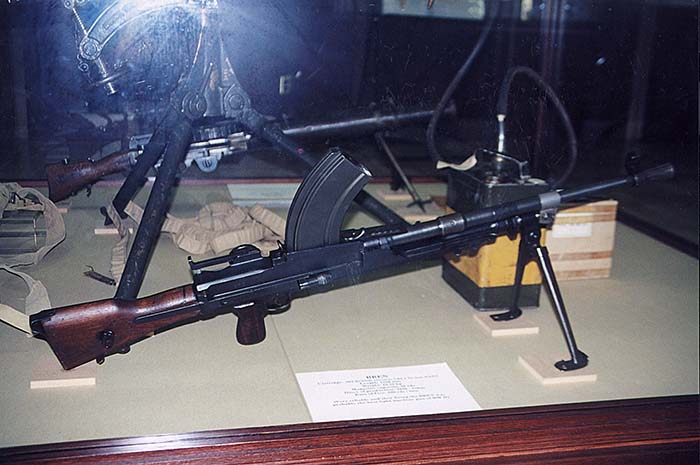
There is an extensive security system including vault doors, multiple locks, and ID card reading keypad lock (all required due to the new Canadian Firearms Regulations) that protect a wide and varied collection of weapons representing the regiment’s various military deployments (as peacekeepers) since the Korean War. Lining the wall were weapons racks with at least thirty bolt action rifles and the occasional muzzle loader, plus a nice selection of Vickers and Maxims (MG08 “Spandaus”) from World War I. Interesting pieces included two Winchester 1876 rifles (.45-74 and .40-60), a VSA MK1 Enfield marked “Royal Navy Volunteer Reserve,” a Danzig made 1888 7.92mm, a Ljungmann AG M42B 6.5X55mm, and a Trapdoor Springfield. Also in the racks were at least one of the following: SKS, AK-47, Sten, Uzi, MP-40, M16A1 Colt, PPD, Thompson, .303 SMLE, Mosin Nagant (including a Mosin Nagant with sniper scope in good condition), MG42, Czech ZB26 MG, Bren, G-3, FN-FAL series C1 and C1A1 rifles and, of course, a Ross rifle.
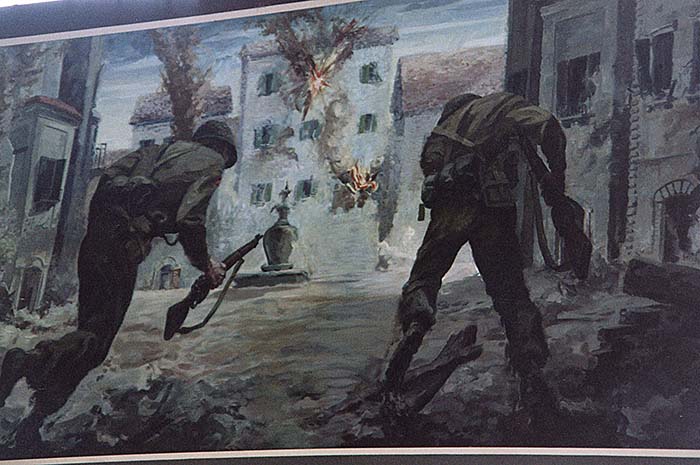
There were so many variations of the Ross rifle (one expert says 85) I couldn’t tell you which one I was looking at, having only seen three or four before in other collections. The Ross was fielded by the Canadian Army in the trenches in 1914, but it wasn’t long before Canuck infantrymen found them ill-suited to the muddy trenches, tossed them away, and picked up Lee-Enfields from the dead. There were three major problems with the rifle:
1) the bolt stop was often damaged by the recurring abutment of the rearmost locking lug during firing-this often froze the bolt in the locked position;
2) the rifle often failed to extract wartime ammunition; and
3) improper re-assembly of the bolt with the distance between the bolt head and bolt sleeve being less than one inch when the bolt is withdrawn from the rifle would cause it to be blown out of the receiver, usually with fatal results.
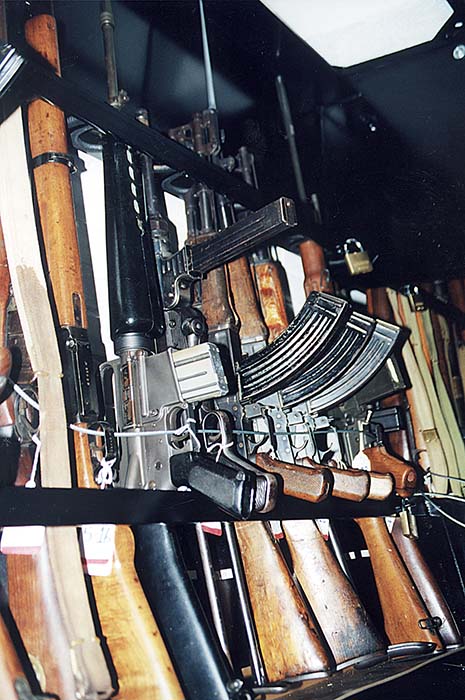
The Ross Rifle
Sir Charles Ross designed it as a straight pull rifle in 1896. Manufactured by the Ross Rifle Company of Quebec it was adopted by the Canadian Department of Militia and Defence as the official rifle of the Royal Northwest Mounted Police. While the original bolt design (Model 1897) had a locking system patterned after the Mannlicher using a bolt locked on an interrupted thread. Ross changed this to a rotating lug system in 1900. A cam track unlocked the bolt when pulled to the rear. The 1910 design (one of which I inspected in the armory) reverted to the interrupted thread design. The Ross in its various incarnations was tested by the British Army several times and consistently rejected. In his 1910 report on the Ross Mark II the Commandant of the Small Arms School at Hythe said: “It seems clear that This rifle is designed as a target rifle pure and simple, without regard to the requirements of active service or the training of large bodies of men of average attainment.” The Mark III Ross was often fitted with a Warner & Swasey *Cleveland, OH) 5.2X scope offset to the left (so the weapon could be loaded via charger). Herbert McBride (author of A Rifleman Went to War) thought the Ross a superior weapon for sniping and noted the speed of its straight pull bolt…then again, McBride wasn’t “of average attainment.”
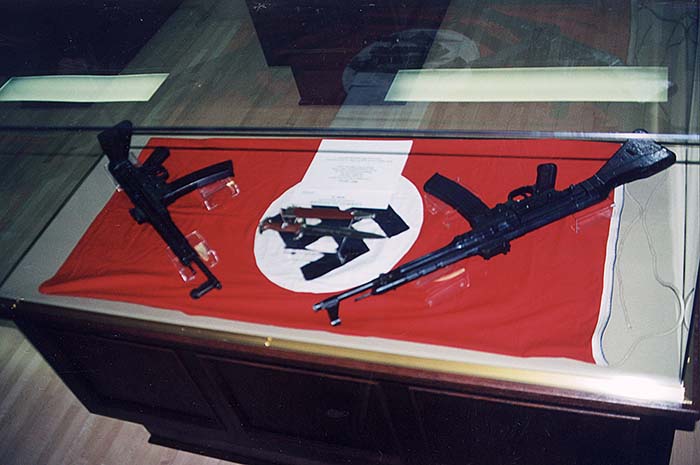
Pistols
Moving to the locked cabinets of the linear storage system Chad showed me the museum’s collection of pistols, military and otherwise. There were trays of Webleys and Enfields, a very nice nickel plated Colt revolver, and another Colt handgun which should be displayed upstairs: a M1911 .45 ACP engraved “LTC W.A. Griesbach,” It was the personal sidearm of the founder of regiment. Other pistols in storage included a 1912 Steyr automatic, a Tokarev, a couple of .32 ACP Colt autos, P-38 Walthers, FN pistols, several Berettas, a Belgian Model 1922 Nazi 626/641, a Hungarian Army 37M “Frommer,” a Mauser Model 34. 1910 6.5mm, and HSC 7.65mm Mausers, and a British Service .38 No.2 Smith and Wesson. Interesting pieces included a 9mm Parabellum Artillery pistol M1908 Luger with its 32 round Snail durm, a really nice Broomhandle Mauser with its holster stock complete with original leather furniture and straps, and a very interesting piece, something I’ve never seen before: a “Brownie” 4-shot “pepperbox” style pocket pistol made by O.F. Mossberg and Sons, New Haven, Conn. There was even a rusted Civil War era Colt Army pistol, dug from some farmer’s field – perhaps lost by some outlaw fleeing justice across the border in Montana.
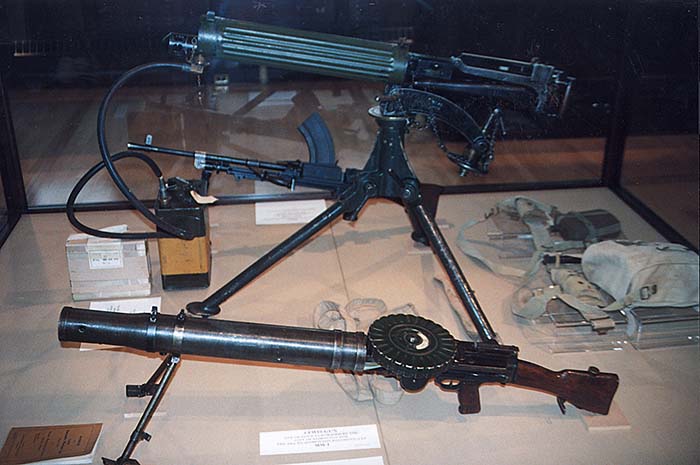
Should you ever find yourself in Edmonton I recommend a visit to the Loyal Edmonton Regiments’ Museum. Admission is free. Viewing hours are Tuesday through Friday 10 am to 4 am. For more information contact: the Loyal Edmonton Regiment Museum, #118 Prince of Wales Armouries Heritage Center, 10440-108 Avenue, Edmonton, Alberta, Canada T5H 3Z9. Phone/Fax (780) 421-9943 or e-mail: lermusm@planet.eon.net.
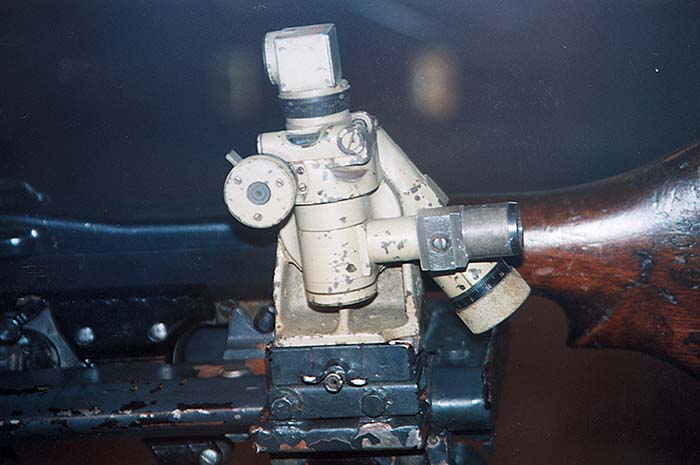
| This article first appeared in Small Arms Review V3N2 (November 1999) |



